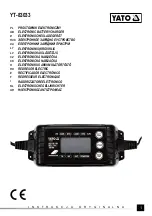
SENS MicroGenius S2/S4 Technical Manual
19
Table 8 – Alarm Relay Contact Wiring for Marine Configuration
Wire from COM to OK for alarm present on open circuit or from COM to FAIL for present on closed circuit.
RELAY 1
RELAY 2
RELAY 3
RELAY 4
RELAY 5
Relay
Contacts
Summary
Alarm*
AC Fail
Ground Fault
Alarm
High DC Alarm
Low DC Alarm
Common
COM (TB1-1)
COM (TB1-4)
COM (TB2-1)
COM (TB2-4)
COM (TB2-7)
Open on
alarm
(normally
closed)
OK (TB1-2)
OK (TB1-5)
OK (TB2-2)
Defaults to OK
with no AC and
DC power
OK (TB2-5)
Defaults to OK
with no AC and
DC power
OK (TB2-8)
Close on
alarm
(normally
open)
FAIL (TB1-3)
Defaults to FAIL
with no AC input
FAIL (TB1-6)
Defaults to FAIL
with no AC input
FAIL (TB2-3)
FAIL (TB2-6)
FAIL (TB2-9)
Defaults to FAIL
with no AC and
DC power
*Summary alarm includes AC Fail, Charger Fail, Ground Fault, High DC and Low DC alarms.
Table 9 – Alarm Relay Contact Wiring for Stationary Power Configuration
Wire from COM to OK for alarm present on open circuit or from COM to FAIL for present on closed circuit.
RELAY 1
RELAY 2
RELAY 3
RELAY 4
RELAY 5
Relay
Contacts
Summary
Alarm*
AC Fail
Battery
Discharging
Alarm
High DC Alarm
Low DC Alarm
Common
COM (TB1-1)
COM (TB1-4)
COM (TB2-1)
COM (TB2-4)
COM (TB2-7)
Open on
alarm
(normally
closed)
OK (TB1-2)
OK (TB1-5)
OK (TB2-2)
OK (TB2-5)
Defaults to OK
with no AC and
DC power
OK (TB2-8)
Close on
alarm
(normally
open)
FAIL (TB1-3)
Defaults to FAIL
with no AC input
FAIL (TB1-6)
Defaults to FAIL
with no AC input
FAIL (TB2-3)
Defaults to FAIL
with no AC and
DC power
FAIL (TB2-6)
FAIL (TB2-9)
Defaults to FAIL
with no AC and
DC power
*Summary alarm includes AC Fail, Charger Fail, Battery Discharging, High DC and Low DC alarms.
6.6.
Remote Temperature Sensor Connection—
Optional
The charger includes local temperature compensation using internal on-board sensors. Alternately, the
charger will use remote temperature compensation based on the temperature of the batteries when an
optional external sensor is located at the batteries and connected to the remote temperature sensor
terminal block in the charger (see Figures 1-3). Chargers with multiple output terminals also include
multiple remote temperature sensor terminal blocks (connect one sensor for each output). Remote
temperature compensation is highly recommended in all applications and is required for ultracapacitor
charging. It is most critical in applications where battery and charger are located in different ambient
conditions and in NFPA-20 fire pump and NFPA-110 emergency power system installations in order to
return 100% of the battery’s ampere-hour rating within 24 hours without causing damage to the battery.
The remote temperature sensor is not polarized; it does not matter which lead connects to each
terminal. Route sensor wiring at least ¼ inch (6 mm) away from DC wiring, AC wiring, and the circuit
board. Locate the remote sensor where it will accurately detect the battery temperature by connecting it
to a
grounded
battery terminal or the battery case. When securing to the battery case, use an
















































